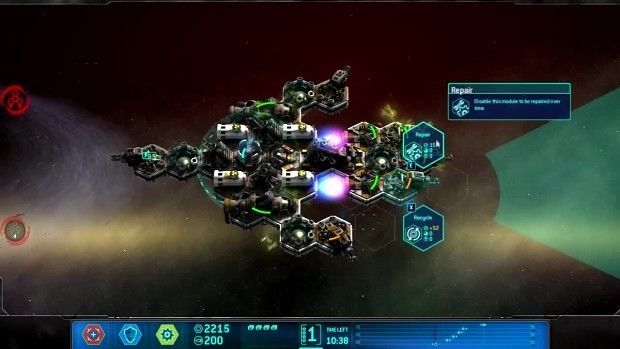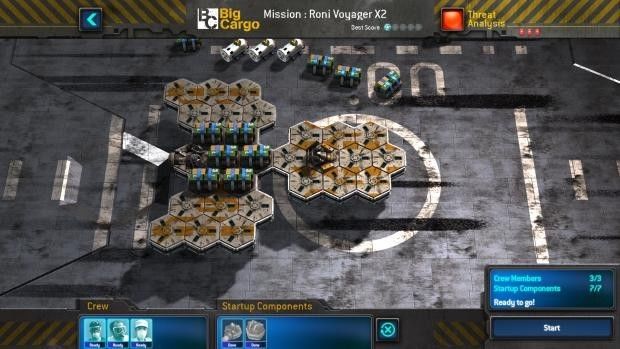And so Space Run does all of this candidly as it tries to deliver a familiar yet accessible space-bound RTS. Does it work? Well, yes and no.
In the year 2525, intergalactic delivery services have been propelled way further than the team behind Amazon’s drone technology could ever have imagined five centuries prior. Interstellar logistics appears to be a booming trade - one which Space Run protagonist Buck Mann has been forced into, following a successful flying career which unfortunately spiralled into a life of high-stakes gambling. Now, indebted to the mob after a run of hard luck, Mann takes on the role of a Space Runner - essentially a delivery man - as he strives to earn Space Credit to pay back what he owes. Accompanied by his right hand android Adaam-12, Buck must battle his way through space corridors filled with asteroids, rogue delivery teams, and high flying pirates in order to successfully ship his freight and ultimately avoid hyper sleeping with the fishes.
 |
| Space Bolts galore |
In any given voyage the rules are simple: defend the ship’s cargo at all costs, fend off any raiders, and reach the assigned destination as quickly as possible. Built from a series of Lego-esque hexagonal shapes, ship structure is intentionally basic whereupon cargo and booster engines take up one slot each. Once embarked, weapons such as turrets and laser cannons can be assigned to the remaining slots, as well as further boosters to enhance speed. Moving from left to right, the corners of the screen can be partially explored by hovering the cursor in any given direction but, in keeping with developer Passtech’s overarching desire to make Space Run an accessible RTS - one minus screeds of instructions - the main flight and battle screen is comprised of just enough options to keep things entertaining, without becoming overly confused.
A linear horse-racing style timeline in the bottom right hand corner indicates the location of the player’s ship, the target destination, and encroaching enemy craft or asteroids. Alongside these icons runs a progressive red marker which indicates each voyage’s time limit; the player must keep ahead in order to successfully complete each mission. Success, then, can only be ascertained by sound combinations of weaponry and speed boosters at the player’s discretion. By simply staying alive, the player accrues a trickling but steady amount of Space Bolts - the currency used to leverage repairs, shields, and new equipment mid-flight - and by decimating space debris and enemy aircraft more still can be drawn on board by hovering the cursor over the selected area. Keeping a cautious eye on your supply of Space Bolts, the journey’s time limit, and available space on the aircraft simultaneously becomes increasingly important - particularly as the waves of enemies in every direction begin to ramp up with each mission in turn.
 |
| Reorient cannons to fend off new threat |
Losing cargo isn’t the end of the world, so long as Buck manages to protect at least one slot. That said, his reputation for the mission in question will rank lower, and thus, result in fewer Space Credits. Each mission is ranked by five stars, allowing plenty of scope for replayability should you fail to achieve full marks the first time round. The ship’s equipment - besides the cargo - can also be repaired mid-flight in exchange for a smattering of Space Bolts, and the laser turrets’ cone of attack can be re-oriented free of charge at any time, set by the mouse wheel. Losing all of the ship’s cargo, or allowing the command bridge (the centre hexagon) to fall, or of course running out of time marks the end of the mission. And then, well, he’s dead, Jim. Sorry, I couldn’t resist.
Once each voyage has been successfully undertaken, the player is returned to the main mission screen wherein ‘Delivery’ and ‘Engineering’ menus facilitate a host of options related to new jobs and craft upgrades respectively. As you’d expect, Space Credits allow for ship expansions, and, as Mann’s reputation improves, other companies begin to reach out with new work. It is within these brief and crude exchanges where Mann displays his arrogant and overtly chauvinistic personality which not only quickly became entirely irritating, but left me questioning the need for such exchanges at all.
 |
| Ship layout becomes gradually more complex |
The main issue with Space Run is that it fails to push itself beyond its initial idea. If it is designed to be an easy-access RTS, then it does so well. But the downside of this, of course, is that - even with a range of ship upgrades, increasingly larger spacecraft, and a host of voice narrated enemy pirates - things become far too repetitive, far too quickly. Sure, I had some very frantic moments where I watched entire wings of my ship get obliterated by an asteroid shower because I couldn’t reorient my laser cannons quick enough; but these moments aside, things become very familiar, very quickly, to the point where they are almost tiresome. And the less said about the protagonist, the better. By paying such homage to the 80s classics which inspired it - even in an age where ‘retro’ interpretations are ala mode - Space Run feels a bit dated.
“When you need it there yesterday,” reads Buck Mann’s catchphrase in reference to his delivery ethos. As far as Space Run: Fast and Safe Delivery as a game is concerned, part of me wonders if yesterday is really where this adventure belongs.
SPACE RUN VERDICT
“When you need it there yesterday,” reads Buck Mann’s catchphrase in reference to his delivery ethos. As far as Space Run: Fast and Safe Delivery as a game is concerned, part of me wonders if yesterday is really where this adventure belongs.




